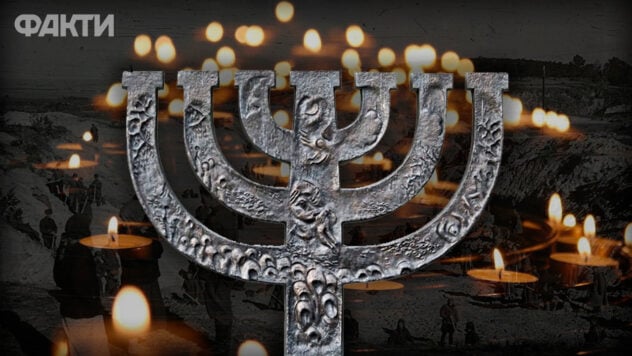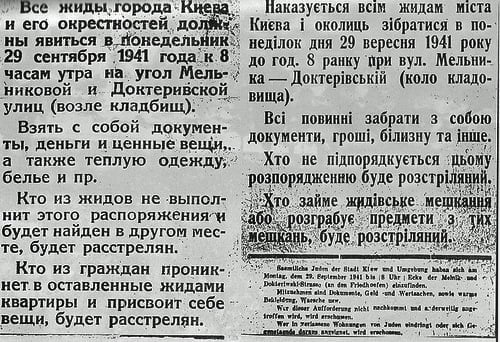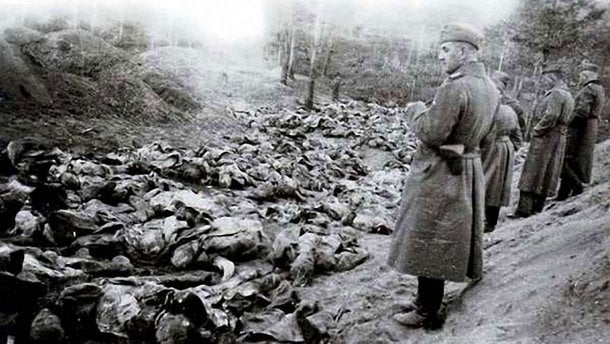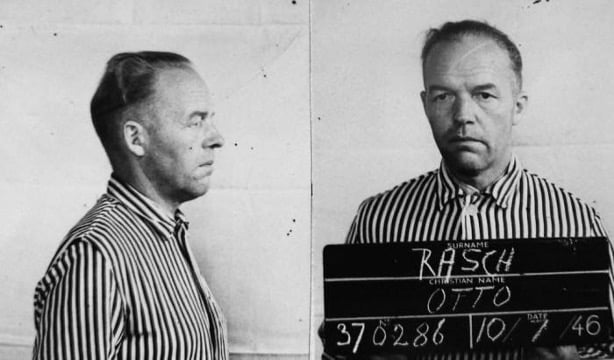
On September 29, Ukraine remembers the victims of the mass shootings at Babi Yar. Between 1941 and 1943, German Nazis deliberately killed more than 100,000 people, mostly Jews. That is why Babi Yar has become another so-called symbol of the Holocaust.
ICTV Facts tell what happened more than 80 years ago in Kyiv and whether the perpetrators were punished.
What preceded the shootings in Babi Yar?
Nazi ideology was based on racial theory, according to which a person's value lies not in his individual traits, but in his belonging to a racial group. The Nazis considered the Aryan race to be the superior race, since they believed that it was the one endowed with the right to conquer or destroy the so-called inferior races, to which the Slavs, in particular the Ukrainians, belonged.
Now watching
The Nazis did not consider Jews to be people at all and at first wanted to resettle them compactly: to the territory of Poland – the Krakow region, to Madagascar or beyond the Ural Mountains.
The Second World War began as a result of a conspiracy between two regimes – the German and the Soviet. Germany and its allies occupied Poland, Lithuania, Latvia, Estonia, and Bessarabia and Bukovina, with 75% of the Jewish population of Europe coming under the rule of these two regimes.
What happened in Babi Yar on September 29-30, 1941?
The Nazis in Kyiv falsely accused the Jews of involvement in the mining and explosions on Khreshchatyk, which killed many Wehrmacht soldiers and officers. In this way, the occupiers wanted to carry out a demonstrative punitive action.
On September 28, 1941, leaflets were posted around Kyiv stating that all Jews should come to the corner of Melnikova & Dokterevskaya Streets with their belongings the following morning. Those who did not do so would be caught and shot. A gate was erected at the end of the street, through which groups of 30-40 people were allowed to pass. A ditch 2.5 km long and up to 50 meters deep was dug for the executions.

Photo: Wikipedia, German command announcement
People were forced to undress, their things were taken away, and then they were driven with truncheons to the embankment on the edge of the ravine. Machine gunners sat on the opposite side. The shots were muffled by music and the noise of an airplane circling over the ravine. The bodies of the dead fell to the bottom.
Researchers say that because most adult men were called up for war, the victims of the shootings were mainly women, children, the elderly, and the sick.
On September 29, about 22,000 people were killed. The next day, almost 12,000 more were killed. However, the total number of those killed during these days may be higher, since the Nazis did not register small children.

UINP
German sappers blew up the slopes of Babi Yar to cover the bodies, and forced Soviet prisoners of war to level them to hide the evidence of the war crime.
Subsequently, about 20,000 more prisoners of war were shot at Babi Yar, including underground fighters, Ukrainian intelligentsia, nationalists, and patients of a mental hospital. Roma were also shot.
According to estimates, between 70,000 and 100,000 people were killed at Babi Yar, two-thirds of whom were Jews. There is also information that about 200 thousand people became victims of the shootings, although it is unlikely that the exact number of the dead will ever be established.
Which of the famous Ukrainians were shot in Babi Yar
In 1942, the famous Ukrainian poetess Elena Teliga was killed in Babi Yar along with her husband Mikhail Teliga. On February 18, 1943, three Dynamo Kyiv football players were shot: Nikolai Trusevich, Ivan Kuzmenko and Alexei Klimenko. In total, 621 Ukrainian patriots were killed in Babi Yar.
Genocide of Jews throughout Ukraine
In Galicia occupied by the Soviet Union, namely in Lviv, 6 thousand Jews were killed in just one week. And in the camps and ghettos of Ternopil, Drohobych, Boryslav, Skole, Stryi and other cities, 610 thousand Jews were executed.
On the territory of the Dnieper Ukraine in the second half of July 1941, the Einsatzkommando of the 5th Einsatzgruppe C (military reconnaissance units created for the extermination of the population and prisoners of war in the occupied territories) shot almost 1.5 thousand Uman Jews.
In August 1941, more than 23,500 Jews were shot in Kamenets-Podolsky, Khmelnytskyi region. In May 1944, those Jews who remained in the territory of Transcarpathian Ukraine were taken to the Auschwitz concentration camp (Poland). Most of them were killed in gas chambers.
At the end of December 1941, more than 40,000 Jews were exterminated near Bohdanovka, Odessa (now Mykolaiv) region.
On July 29, 1941, the Nazis shot 146 Jews in Vinnitsa. Between September 5 and September 20 of the same year, Einsatzgruppe C and auxiliary police units, according to researchers, killed about 16 thousand Jews. In total, from 20 to 26 thousand Jews were killed in Vinnitsa. According to the USSR census, in 1939, about 33,150 Jews lived in the city.
According to the Ukrainian Institute of National Remembrance, more than 1 million Jews fell victim to the Holocaust in Ukraine.
Soviet policy of concealing war crimes
Before fleeing Kyiv, the Nazis decided to hide their war crime. During August-September 1943, prisoners of the Syrets camp dug up corpses, burned them, scattered the ashes, and ground up the solid remains. Perhaps that is why we will never know how many people actually died there.
The Soviet government initially wanted to build a memorial, but later abandoned the idea — they decided to fill the site with waste from brick production, cover it with earth, plant trees, arrange streets and build houses.
The monument to the victims of Babi Yar was erected under public pressure only in 1976. However, the Soviet government decided not to mention that most of those killed were Jews.
Punishment for the crime of genocide
In January 1946, 15 members of the German police were brought to trial in Kyiv for crimes committed at Babi Yar. Actress Dina Pronicheva, who witnessed the events at Babi Yar first-hand, testified:
— Each time I saw a new group of men and women, old people and children, who were forced to undress. They were all led to a ditch, where machine gunners shot them. Then they brought in the next group… I saw this horror with my own eyes. Although I was not standing close to the pit, I could hear the terrible screams of frightened people and the quiet voices of children calling: Mom, mom…
Researchers have managed to establish the names of 161 Nazis involved in the shootings at Babi Yar. Here are some of them:
Kurt Eberhard— Kyiv city commandant, gave the order to exterminate the Jews. Committed suicide in American captivity.
Bernhard Grafhorst — led a company that participated in the execution of 402 Jews in Zhitomir on August 7, 1941. On September 29-30, 1941, the company shot Kyiv Jews.
Former SS-Obersturmführer August Häfner supervised the shootings on September 29-30, 1941.
Czech Viktor Trill collaborated with the Nazis. At first he was a truck driver, then he was assigned to shoot Jews:
— I had to take part in a large shooting of Jews… I had to shoot for about 10 minutes then, and during that time I personally shot about 30-50 Jews. I remember that they shot men and women of all ages.
Paul Blobel — SS-Standartenführer, commander of Sonderkommando 4a, directly supervised the executions at Babi Yar in the autumn of 1941. Executed by hanging in 1951 in Germany.

In the photo: Otto Rasch. Commander of Einsatzgruppe S. One of the organizers of the murder of Jews at Babi Yar.
Kuno Callsen — Deputy commander of Sonderkommando 4a, one of the leaders of the executions at Babi Yar. Received a 15-year sentence of hard labor. Died in 2001 in Germany.
Kurt Hans — Unit commander in Sonderkommando 4a. Led the firing squads. Sentenced to 11 years in prison. However, he served two years and was released due to health reasons. He died in 1997 in Germany.
According to the Babi Yar Memorial Center, despite evidence, confessions, and testimonies from some of the Nazi soldiers who committed the murders, only a few have been convicted.

